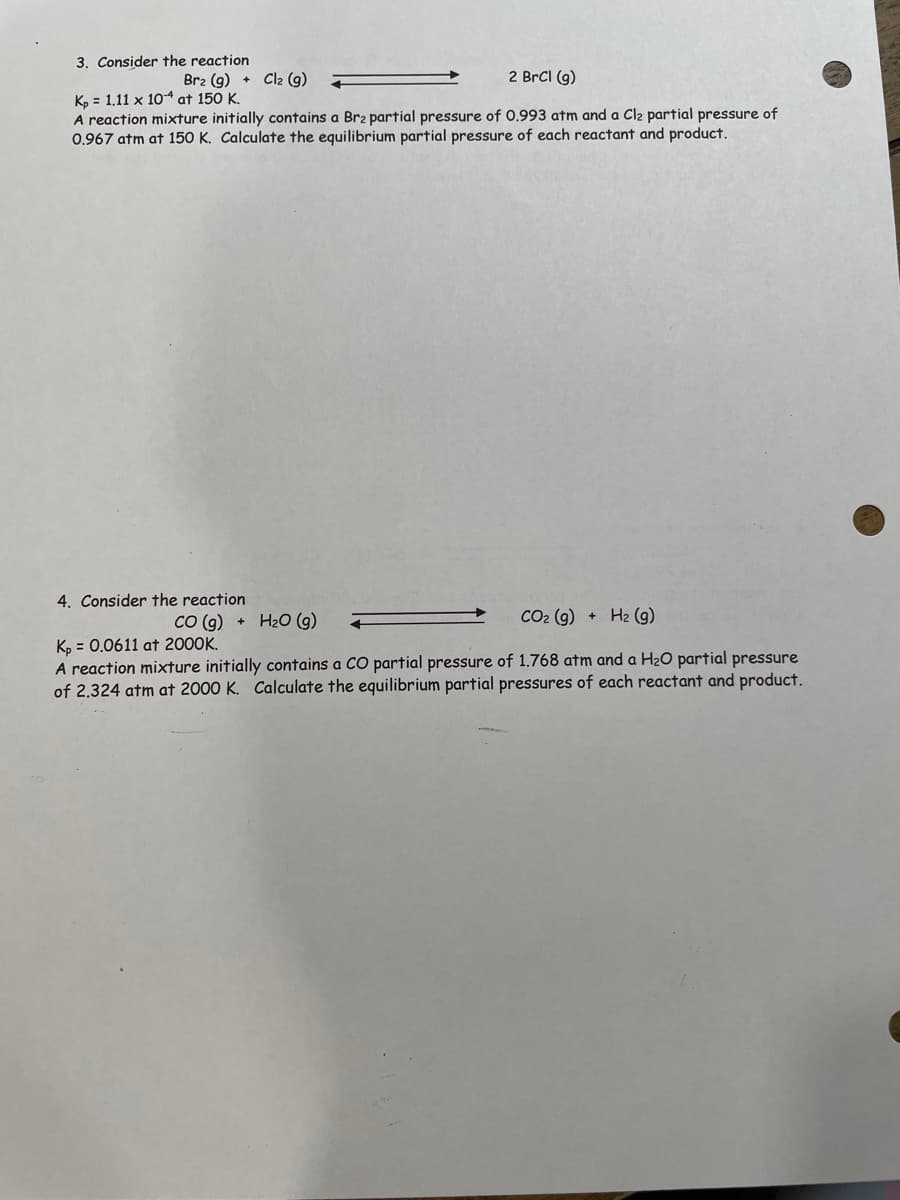3. Consider the reaction Br2 (g) + Cl2 (9) 2 BrCl (g) Kp = 1.11 x 10 at 150 K. A reaction mixture initially contains a Br₂ partial pressure of 0.993 atm and a Cl₂ partial pressure of 0.967 atm at 150 K. Calculate the equilibrium partial pressure of each reactant and product. 4. Consider the reaction CO (g) + H₂O (g) CO₂ (g) + H₂ (g) A reaction mixture initially contains a CO partial pressure of 1.768 atm and a H₂O partial pressure of 2.324 atm at 2000 K. Calculate the equilibrium partial pressures of each reactant and product. p= 0.0611 at 2000K.
3. Consider the reaction Br2 (g) + Cl2 (9) 2 BrCl (g) Kp = 1.11 x 10 at 150 K. A reaction mixture initially contains a Br₂ partial pressure of 0.993 atm and a Cl₂ partial pressure of 0.967 atm at 150 K. Calculate the equilibrium partial pressure of each reactant and product. 4. Consider the reaction CO (g) + H₂O (g) CO₂ (g) + H₂ (g) A reaction mixture initially contains a CO partial pressure of 1.768 atm and a H₂O partial pressure of 2.324 atm at 2000 K. Calculate the equilibrium partial pressures of each reactant and product. p= 0.0611 at 2000K.
Chemistry: Principles and Reactions
8th Edition
ISBN:9781305079373
Author:William L. Masterton, Cecile N. Hurley
Publisher:William L. Masterton, Cecile N. Hurley
Chapter12: Gaseous Chemical Equilibrium
Section: Chapter Questions
Problem 56QAP: Sulfur oxychloride, SO2Cl2, decomposes to sulfur dioxide and chlorine gases. SO2Cl2(g)SO2(g)+Cl2(g)...
Related questions
Question

Transcribed Image Text:3. Consider the reaction
Br2 (g) + Cl2 (g)
2 BrCl (g)
Kp = 1.11 x 104 at 150 K.
A reaction mixture initially contains a Br2 partial pressure of 0.993 atm and a Cl2 partial pressure of
0.967 atm at 150 K. Calculate the equilibrium partial pressure of each reactant and product.
4. Consider the reaction
CO₂ (g) + H2 (g)
A reaction mixture initially contains a CO partial pressure of 1.768 atm and a H₂O partial pressure
of 2.324 atm at 2000 K. Calculate the equilibrium partial pressures of each reactant and product.
CO (g) + H₂O (g)
Kp = 0.0611 at 2000K.
Expert Solution
This question has been solved!
Explore an expertly crafted, step-by-step solution for a thorough understanding of key concepts.
Step by step
Solved in 3 steps with 2 images

Knowledge Booster
Learn more about
Need a deep-dive on the concept behind this application? Look no further. Learn more about this topic, chemistry and related others by exploring similar questions and additional content below.Recommended textbooks for you

Chemistry: Principles and Reactions
Chemistry
ISBN:
9781305079373
Author:
William L. Masterton, Cecile N. Hurley
Publisher:
Cengage Learning

Chemistry: The Molecular Science
Chemistry
ISBN:
9781285199047
Author:
John W. Moore, Conrad L. Stanitski
Publisher:
Cengage Learning

Chemistry: An Atoms First Approach
Chemistry
ISBN:
9781305079243
Author:
Steven S. Zumdahl, Susan A. Zumdahl
Publisher:
Cengage Learning

Chemistry: Principles and Reactions
Chemistry
ISBN:
9781305079373
Author:
William L. Masterton, Cecile N. Hurley
Publisher:
Cengage Learning

Chemistry: The Molecular Science
Chemistry
ISBN:
9781285199047
Author:
John W. Moore, Conrad L. Stanitski
Publisher:
Cengage Learning

Chemistry: An Atoms First Approach
Chemistry
ISBN:
9781305079243
Author:
Steven S. Zumdahl, Susan A. Zumdahl
Publisher:
Cengage Learning

Chemistry & Chemical Reactivity
Chemistry
ISBN:
9781337399074
Author:
John C. Kotz, Paul M. Treichel, John Townsend, David Treichel
Publisher:
Cengage Learning

General Chemistry - Standalone book (MindTap Cour…
Chemistry
ISBN:
9781305580343
Author:
Steven D. Gammon, Ebbing, Darrell Ebbing, Steven D., Darrell; Gammon, Darrell Ebbing; Steven D. Gammon, Darrell D.; Gammon, Ebbing; Steven D. Gammon; Darrell
Publisher:
Cengage Learning

Chemistry
Chemistry
ISBN:
9781305957404
Author:
Steven S. Zumdahl, Susan A. Zumdahl, Donald J. DeCoste
Publisher:
Cengage Learning